2013 MERCEDES-BENZ G-CLASS SUV air conditioning
[x] Cancel search: air conditioningPage 6 of 364
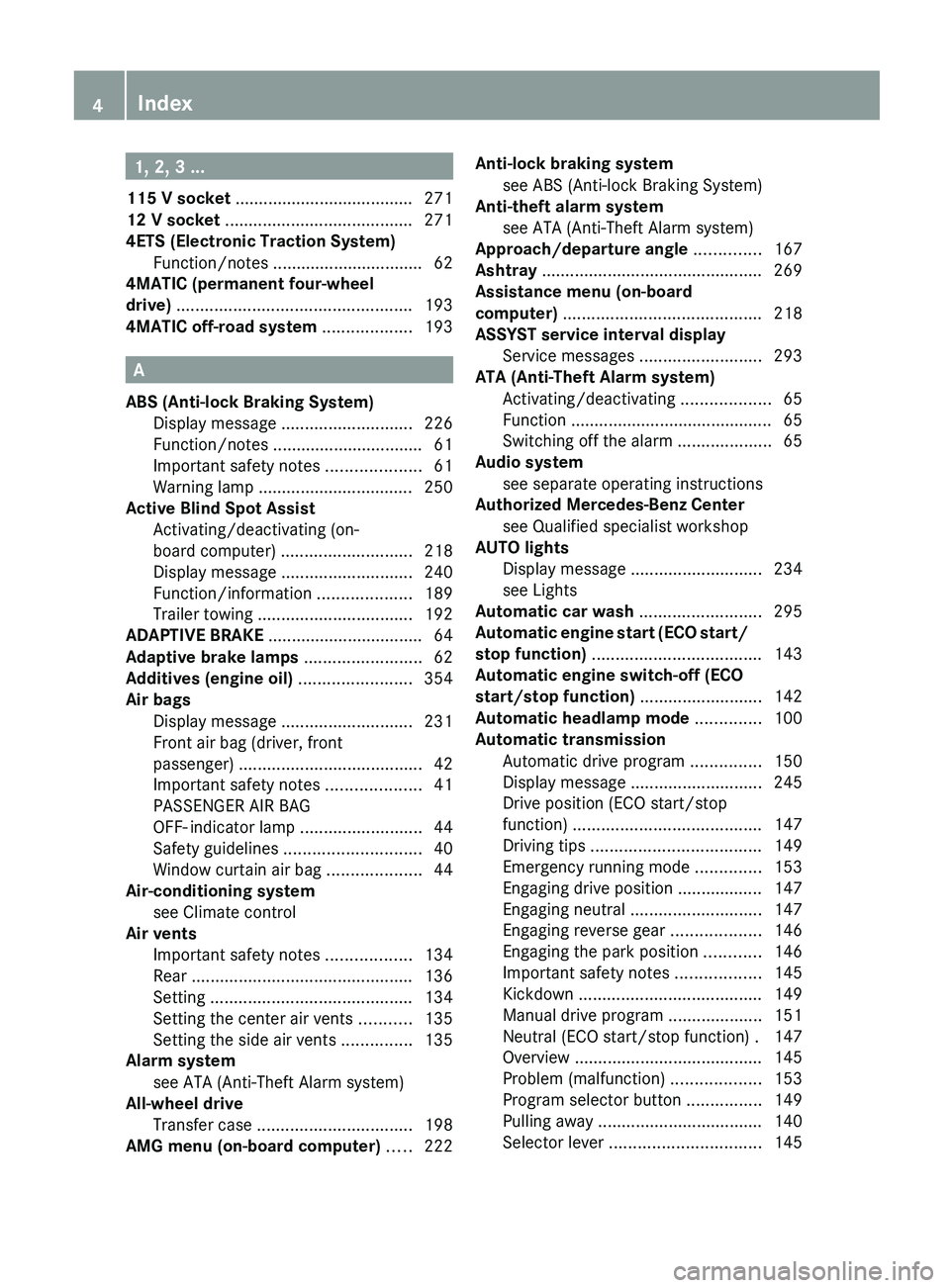
1, 2, 3 ...
115 V socket ...................................... 271
12 V socket ........................................ 271
4ETS (Electronic Traction System) Function/notes ................................
62
4MATIC (permanent four-wheel
drive) .................................................. 193
4MATIC off-road system ................... 193A
ABS (Anti-lock Braking System) Display message ............................ 226
Function/notes ................................ 61
Important safety notes
....................61
Warning lamp ................................. 250
Active Blind Spot Assist
Activating/deactivating (on-
board computer) ............................ 218
Display message ............................ 240
Function/information .................... 189
Trailer towing ................................. 192
ADAPTIVE BRAKE ................................. 64
Adaptive brake lamps .........................62
Additives (engine oil) ........................354
Air bags Display message ............................ 231
Front air bag (driver, front
passenger) ....................................... 42
Important safety notes .................... 41
PASSENGER AIR BAG
OFF- indicator lamp .......................... 44
Safety guidelines ............................. 40
Window curtain air bag ....................44
Air-conditioning system
see Climate control
Air vents
Important safety notes .................. 134
Rear ............................................... 136
Setting ........................................... 134
Setting the center air vents ...........135
Setting the side air vents ............... 135
Alarm system
see ATA (Anti-Theft Alarm system)
All-wheel drive
Transfer case ................................. 198
AMG menu (on-board computer) ..... 222Anti-lock braking system
see ABS (Anti-lock Braking System)
Anti-theft alarm system
see ATA (Anti-Theft Alarm system)
Approach/departure angle ..............167
Ashtray ............................................... 269
Assistance menu (on-board
computer) .......................................... 218
ASSYST service interval display Service messages .......................... 293
ATA (Anti-Theft Alarm system)
Activating/deactivating ................... 65
Function ........................................... 65
Switching off the alarm .................... 65
Audio system
see separate operating instructions
Authorized Mercedes-Benz Center
see Qualified specialist workshop
AUTO lights
Display message ............................ 234
see Lights
Automatic car wash .......................... 295
Automatic engine start (ECO start/
stop function) .................................... 143
Automatic engine switch-off (ECO
start/stop function) .......................... 142
Automatic headlamp mode ..............100
Automatic transmission Automatic drive program ............... 150
Display message ............................ 245
Drive position (ECO start/stop
function) ........................................ 147
Driving tips .................................... 149
Emergency running mode ..............153
Engaging drive position .................. 147
Engaging neutral ............................ 147
Engaging reverse gear ................... 146
Engaging the park position ............ 146
Important safety notes .................. 145
Kickdown ....................................... 149
Manual drive program ....................151
Neutral (ECO start/stop function) . 147
Overview ........................................ 145
Problem (malfunction) ...................153
Program selector button ................149
Pulling away ................................... 140
Selector lever ................................ 1454
Index
Page 16 of 364

Remote control
Programming (garage door
opener) .......................................... 281
Reporting safety defects .................... 24
Reserve (fuel tank) see Fuel
Reserve fuel
Display message ............................ 237
Warning lamp ................................. 256
see Fuel
Residual heat
Switching on/off ........................... 134
Restraint systems
see SRS (Supplemental Restraint
System)
Reversing lamps (display
message) ............................................ 233
Roadside Assistance (breakdown) ....22
Roof lining and carpets (cleaning
guidelines) ......................................... 300
Route (navigation) see Route guidance (navigation)
Route guidance (navigation) ............214S
Safety Children in the vehicle .....................54
Child restraint systems ....................54
Safety system
see Driving safety systems
Seat backrest
Folding back .................................. 265
Seat belts
Adjusting the height ......................... 52
Belt force limiters ............................ 53
Cleaning ......................................... 300
Correct usage .................................. 49
Emergency Tensioning Devices ........ 53
Fastening ......................................... 50
Fastening, front ............................... 51
Fastening in the rear, center ............51
Important safety guidelines .............48
Releasing ......................................... 52
Safety guidelines ............................. 40
Special seat belt retractor ............... 56
Warning lamp ................................. 248
Warning lamp (function) ................... 53 Seat heating
Indicator lamp (malfunction) ............ 90
Seats
Adjusting (electrically) .....................86
Adjusting the 4-way lumbar
support ............................................ 89
Adjusting the head restraint ............ 86
Cleaning the cover .........................299
Correct driver's seat position ...........
84
Important safety notes .................... 85
Overview .......................................... 85
Storing settings (memory
function) .......................................... 95
Switching seat heating on/off ......... 89
Switching seat ventilation on/off ....90
Seat ventilation
Indicator lamp (malfunction) ............ 90
Sensors (cleaning instructions) .......297
Service interval display Displaying a service message (on-
board computer) ............................ 293
Service menu (on-board computer) . 218
Service products Brake fluid ..................................... 354
Coolant (engine) ............................ 354
Engine oil ....................................... 353
Fuel ................................................ 350
Important safety notes .................. 350
Notes ............................................. 350
Refrigerant (air-conditioning
system) .......................................... 354
Washer fluid ................................... 356
Setting a speed limit
see SPEEDTRONIC
Settings
Calling up a stored setting ............... 96
Factory (on-board computer) ......... 222
On-board computer ....................... 218
Setting the air distribution ...............131
SETUP (on-board computer) ............. 222
Shift ranges ....................................... 150
Side marker lamp (display
message) ............................................ 233
Side marker lamps (changing
bulbs) ................................................. 11214
Index
Page 123 of 364
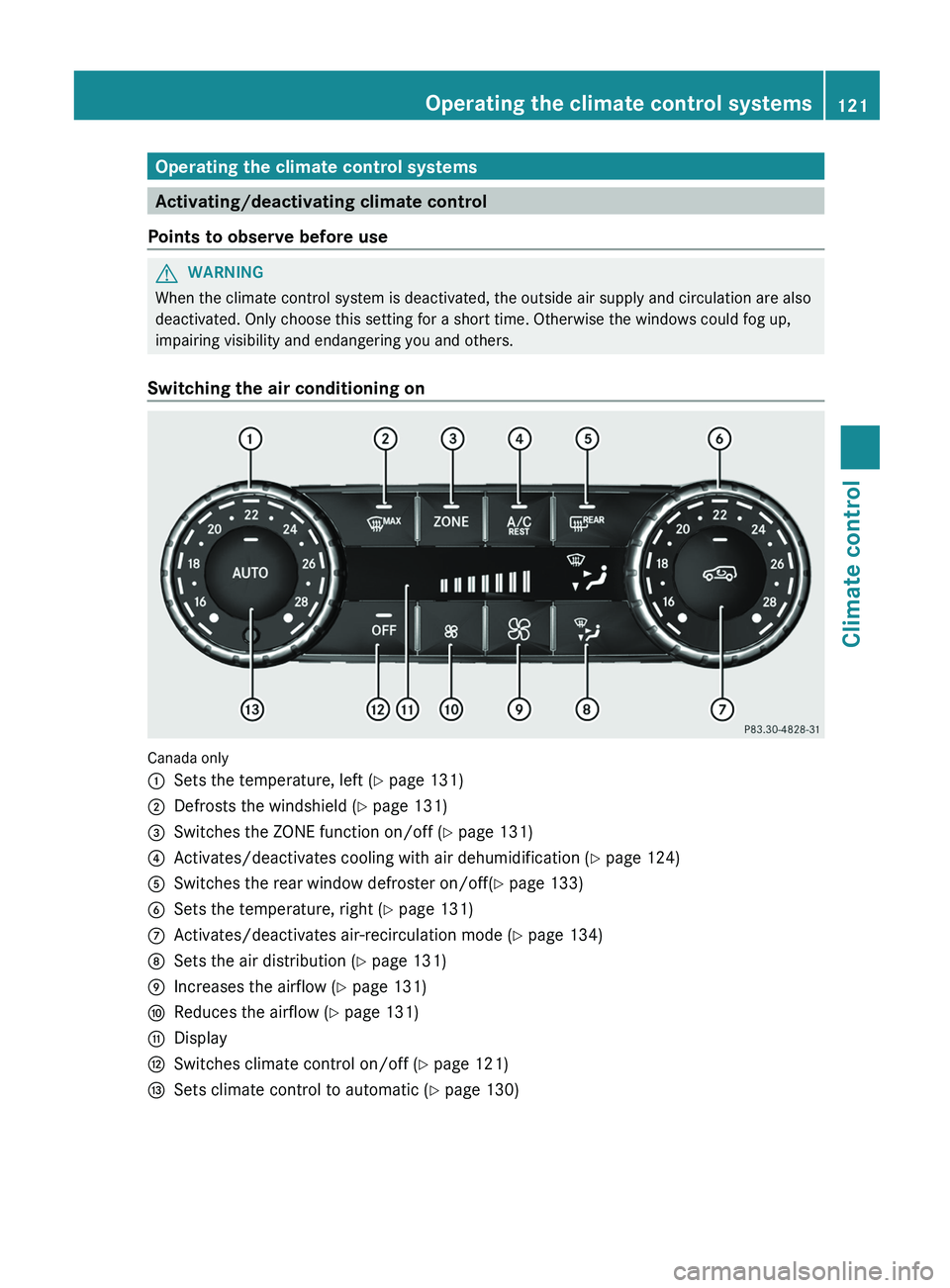
Operating the climate control systems
Activating/deactivating climate control
Points to observe before use G
WARNING
When the climate control system is deactivated, the outside air supply and circulation are also
deactivated. Only choose this setting for a short time. Otherwise the windows could fog up,
impairing visibility and endangering you and others.
Switching the air conditioning on Canada only
0043
Sets the temperature, left ( Y page 131)
0044 Defrosts the windshield ( Y page 131)
0087 Switches the ZONE function on/off ( Y page 131)
0085 Activates/deactivates cooling with air dehumidification ( Y page 124)
0083 Switches the rear window defroster on/off( Y page 133)
0084 Sets the temperature, right ( Y page 131)
006B Activates/deactivates air-recirculation mode (Y page 134)
006C Sets the air distribution (Y page 131)
006D Increases the airflow ( Y page 131)
006E Reduces the airflow ( Y page 131)
006F Display
0070 Switches climate control on/off ( Y page 121)
0071 Sets climate control to automatic (Y page 130) Operating the climate control systems
121Climate control Z
Page 136 of 364

Activating/deactivating air-
recirculation mode
G
WARNING
Fogged windows impair visibility,
endangering you and others. If the windows
begin to fog on the inside, switching off the
air recirculation mode immediately should
clear interior window fogging. If interior
window fogging persists, make sure the air
conditioning is activated, or press the 0064
button.
X Turn the SmartKey to position
2 (Y page 139) in the ignition lock.
X To switch on: press the 0089 button.
The indicator lamp
in
the 0089 button lights
up.
i Air-recirculation mode is automatically
activated at high levels of pollution or at
high outside temperatures. When air-
recirculation mode is activated
automatically, the indicator lamp in the
0089 button is not lit.
Outside air is added after approximately
30 minutes.
X To deactivate: press the 0089 button.
The indicator lamp in
the 0089 button goes
out.
i Air-recirculation mode switches off
automatically:
R after approximately five minutes at
outside temperatures below
approximately 41 ‡
R after approximately five minutes if
cooling with air dehumidification is
deactivated
R after approximately 30 minutes at
outside temperatures above
approximately 41 ‡ (5 †) Activating/deactivating the residual
heat function
The "residual heat" function is only available
in Canada.
It is possible to
make use of the residual heat
of the engine to continue heating the
stationary vehicle for up to 30 minutes after
the engine has been switched off. The heating
time depends on the coolant temperature and
on the interior temperature that has been set.
i The blower will run at a low speed
regardless of the airflow setting.
i If you activate the residual heat function
at high temperatures, only the ventilation
will be activated.
X Turn the SmartKey to position
0(Y page 139) in the ignition lock or
remove it.
X To activate: press the 0056 button.
The indicator lamp
in
the 0056 button lights
up.
X To deactivate: press the 0056 button.
The indicator lamp in
the 0056 button goes
out.
i Residual heat is deactivated
automatically:
R after approximately 30 minutes
R when the ignition is switched on
R if the battery voltage drops
R if the coolant temperature is too low Setting the air vents
Important safety notes
G
WARNING
When operating the climate control, the air
that enters the passenger compartment
through the air vents can be very hot or very
cold (depending on the
set temperature). This
could cause burns or frostbite to unprotected
skin in the immediate area of the air vents. 134
Setting the air vents
Climate control
Page 145 of 364
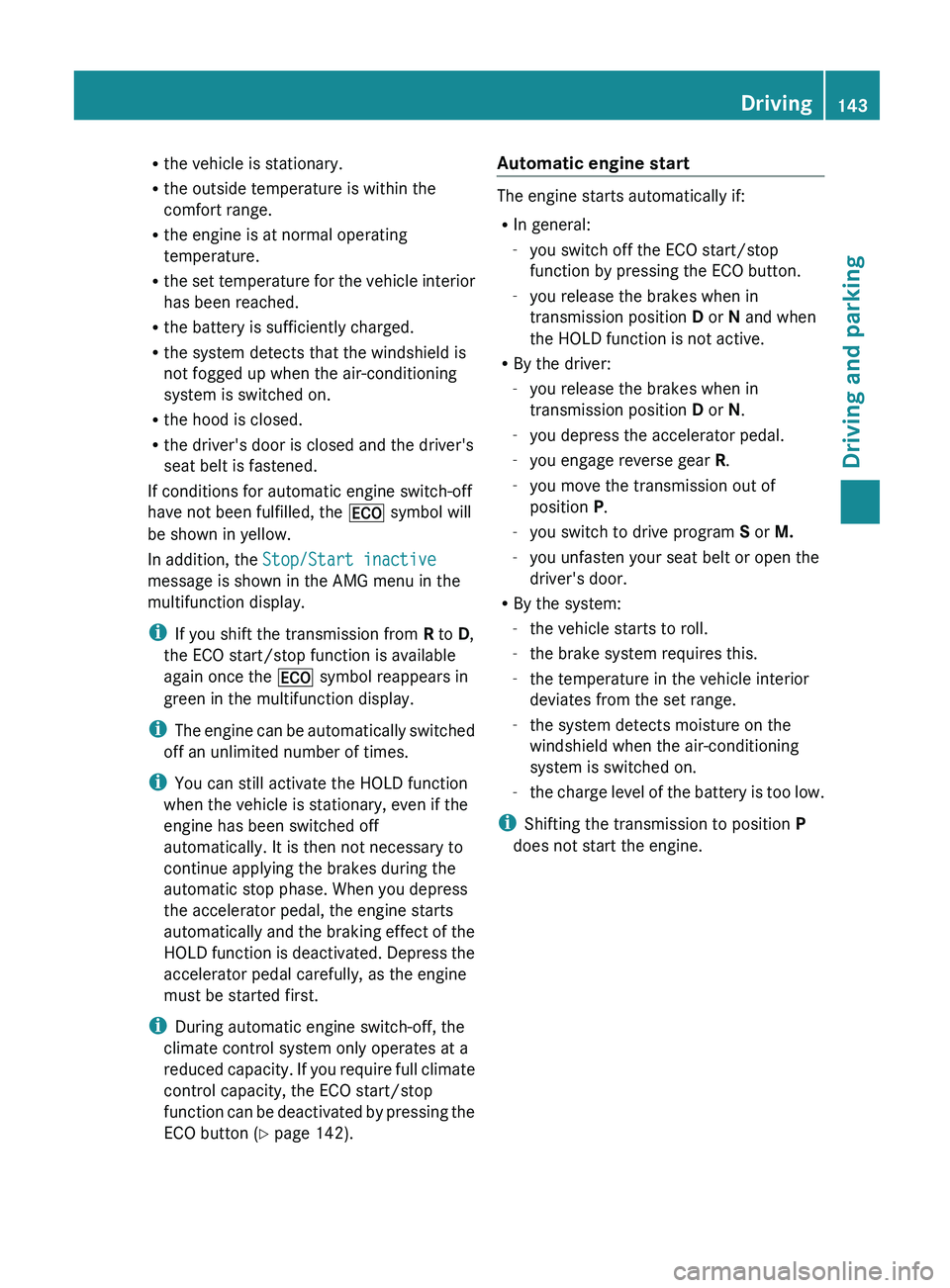
R
the vehicle is stationary.
R the outside temperature is within the
comfort range.
R the engine is at normal operating
temperature.
R the set temperature for
the vehicle interior
has been reached.
R the battery is sufficiently charged.
R the system detects that the windshield is
not fogged up when the air-conditioning
system is switched on.
R the hood is closed.
R the driver's door is closed and the driver's
seat belt is fastened.
If conditions for automatic engine switch-off
have not been fulfilled, the 00A7 symbol will
be shown in yellow.
In addition, the Stop/Start inactive
message is shown in the AMG menu in the
multifunction display.
i If you shift the transmission from R to D,
the ECO start/stop function is available
again once the 00A7 symbol reappears in
green in the multifunction display.
i The engine can be automatically switched
off an unlimited number of times.
i You can still activate the HOLD function
when the vehicle is stationary, even if the
engine has been switched off
automatically. It is then not necessary to
continue applying the brakes during the
automatic stop phase. When you depress
the accelerator pedal, the engine starts
automatically and the braking effect of the
HOLD function is deactivated. Depress the
accelerator pedal carefully, as the engine
must be started first.
i During automatic engine switch-off, the
climate control system only operates at a
reduced capacity. If you require full climate
control capacity, the ECO start/stop
function can be deactivated by pressing the
ECO button ( Y page 142). Automatic engine start The engine starts automatically if:
R
In general:
-you switch off the ECO start/stop
function by pressing the ECO button.
- you release the brakes when in
transmission position D or N and when
the HOLD function is not active.
R By the driver:
-you release the brakes when in
transmission position D or N.
- you depress the accelerator pedal.
- you engage reverse gear R.
- you move the transmission out of
position P.
- you switch to drive program S or M.
- you unfasten your seat belt or open the
driver's door.
R By the system:
-the vehicle starts to roll.
- the brake system requires this.
- the temperature in the vehicle interior
deviates from the set range.
- the system detects moisture on the
windshield when the air-conditioning
system is switched on.
- the charge level of
the battery is too low.
i Shifting the transmission to position P
does not start the engine. Driving
143
Driving and parking Z
Page 165 of 364

R
Switch off the air-conditioning system.
R
R Shift the transfer case to LOW
RANGE(Y page 198).
R Engage the differential locks, if necessary
(Y page 201).
R Restrict the shift range to 1 or
2(Y page 150).
R Avoid high engine speeds.
R Enter and exit the
water at a flat place and
at a steady walking pace.
R Drive slowly and at an even speed through
the water.
R Do not stop and do not switch off the
engine.
R Water offers a high degree of resistance,
and the ground is slippery and in some
cases unstable. Therefore, it is difficult and
dangerous to pull away in the water.
R Ensure that a bow wave does not form as
you drive.
R Clean any mud from the tire tread after
fording.
R Apply the brakes to dry them after fording.
R Water offers a high degree of resistance,
and the ground is slippery and in some
cases unstable. Therefore, it is difficult and
dangerous to pull away in the water.
R Ensure that a bow wave does not form as
you drive.
R Clean any mud from the tire tread after
fording.
R Apply the brakes to dry them after fording. Winter driving
General notes G
DANGER
If the exhaust pipe is blocked or adequate
ventilation is not possible, poisonous gases
such as carbon monoxide
(CO) may enter the
vehicle. This is the case, e.g. if the vehicle becomes trapped in snow. There is a risk of
fatal injury.
If you leave
the
engine or the auxiliary heating
running, make sure the exhaust pipe and area
around the vehicle are clear of snow. To
ensure an adequate supply of fresh air, open
a window on the side of the vehicle that is not
facing into the wind. G
WARNING
If snow chains are installed to the front
wheels, they may drag against the vehicle
body or chassis components. This could
cause damage to the vehicle or the tires.
There is a risk of an accident.
To avoid hazardous situations:
R never install snow chains to the front
wheels
R always install snow chains in pairs to the
rear wheels.
Have your vehicle winterproofed
at a qualified
specialist workshop at the onset of winter.
Observe the notes in the "Winter operation"
section ( Y page 320).
Driving with summer tires Observe the notes in the "Winter operation"
section (
Y page 320).
Slippery road surfaces G
WARNING
If you shift down on a slippery road surface in
an attempt to increase the engine's braking
effect, the drive wheels could lose their grip.
There is an increased danger of skidding and
accidents.
Do not shift down for additional engine
braking on a slippery road surface. G
WARNING
The outside temperature indicator is not
designed to serve as an ice-warning device
and is therefore unsuitable for that purpose. Driving tips
163
Driving and parking
Z
Page 341 of 364
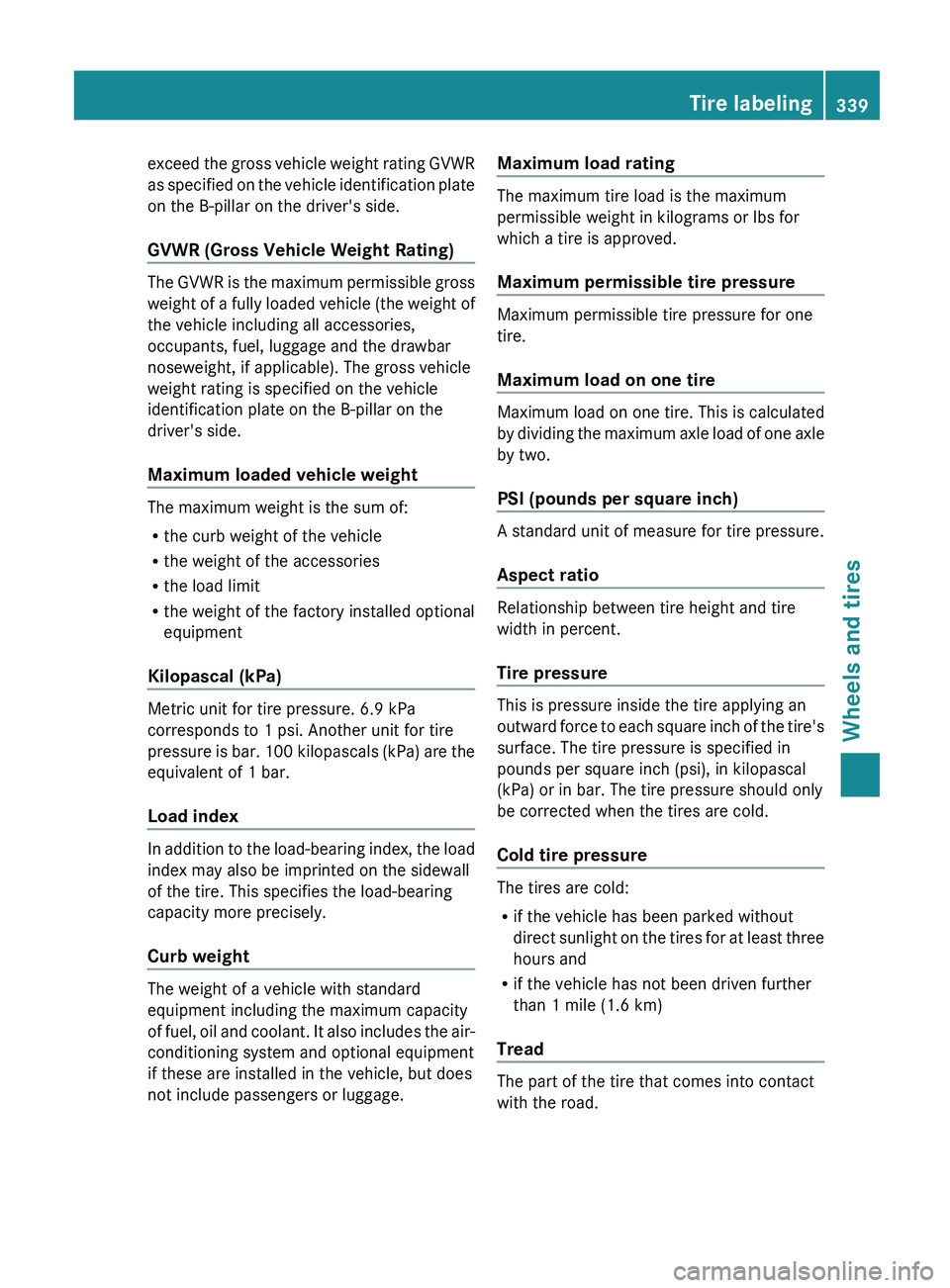
exceed the gross vehicle weight rating GVWR
as specified on
the
vehicle identification plate
on the B-pillar on the driver's side.
GVWR (Gross Vehicle Weight Rating) The GVWR is the maximum permissible gross
weight of a
fully
loaded vehicle (the weight of
the vehicle including all accessories,
occupants, fuel, luggage and the drawbar
noseweight, if applicable). The gross vehicle
weight rating is specified on the vehicle
identification plate on the B-pillar on the
driver's side.
Maximum loaded vehicle weight The maximum weight is the sum of:
R
the curb weight of the vehicle
R the weight of the accessories
R the load limit
R the weight of the factory installed optional
equipment
Kilopascal (kPa) Metric unit for tire pressure. 6.9 kPa
corresponds to 1 psi. Another unit for tire
pressure is bar.
100
kilopascals (kPa) are the
equivalent of 1 bar.
Load index In addition to the load-bearing index, the load
index may also be imprinted on the sidewall
of the tire. This specifies the load-bearing
capacity more precisely.
Curb weight
The weight of a vehicle with standard
equipment including the maximum capacity
of
fuel, oil
and
coolant. It also includes the air-
conditioning system and optional equipment
if these are installed in the vehicle, but does
not include passengers or luggage. Maximum load rating The maximum tire load is the maximum
permissible weight in kilograms or lbs for
which a tire is approved.
Maximum permissible tire pressure
Maximum permissible tire pressure for one
tire.
Maximum load on one tire
Maximum load on one tire. This is calculated
by dividing the
maximum
axle load of one axle
by two.
PSI (pounds per square inch) A standard unit of measure for tire pressure.
Aspect ratio
Relationship between tire height and tire
width in percent.
Tire pressure
This is pressure inside the tire applying an
outward force to
each
square inch of the tire's
surface. The tire pressure is specified in
pounds per square inch (psi), in kilopascal
(kPa) or in bar. The tire pressure should only
be corrected when the tires are cold.
Cold tire pressure The tires are cold:
R
if the vehicle has been parked without
direct sunlight on the
tires for at least three
hours and
R if the vehicle has not been driven further
than 1 mile (1.6 km)
Tread The part of the tire that comes into contact
with the road. Tire labeling
339
Wheels and tires Z
Page 356 of 364
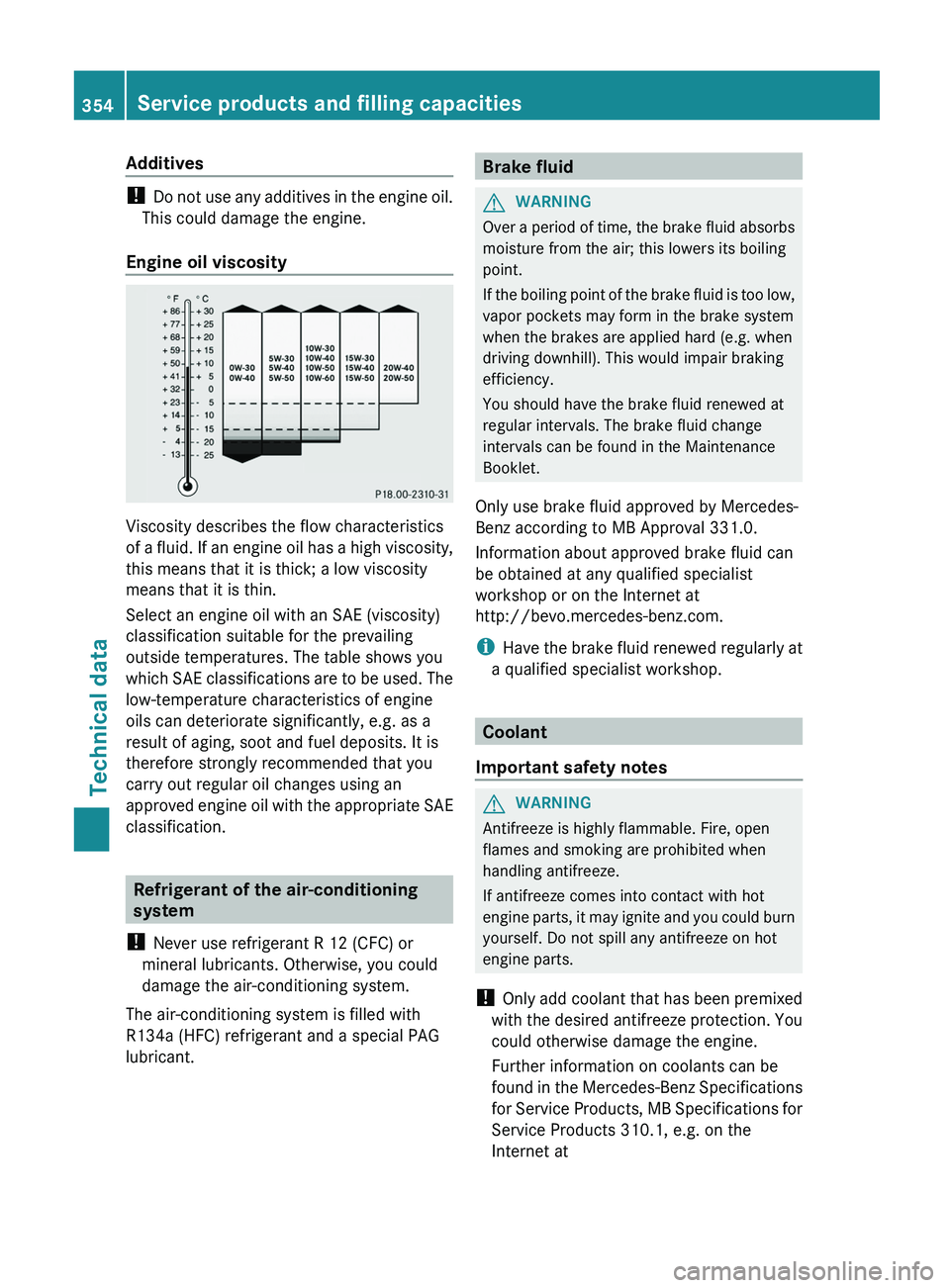
Additives
!
Do not use any
additives in the engine oil.
This could damage the engine.
Engine oil viscosity Viscosity describes the flow characteristics
of a fluid.
If
an engine oil has a high viscosity,
this means that it is thick; a low viscosity
means that it is thin.
Select an engine oil with an SAE (viscosity)
classification suitable for the prevailing
outside temperatures. The table shows you
which SAE classifications are to be used. The
low-temperature characteristics of engine
oils can deteriorate significantly, e.g. as a
result of aging, soot and fuel deposits. It is
therefore strongly recommended that you
carry out regular oil changes using an
approved engine oil with the appropriate SAE
classification. Refrigerant of the air-conditioning
system
! Never use refrigerant R 12 (CFC) or
mineral lubricants. Otherwise, you could
damage the air-conditioning system.
The air-conditioning system is filled with
R134a (HFC) refrigerant and a special PAG
lubricant. Brake fluid
G
WARNING
Over a period of time, the brake fluid absorbs
moisture from the air; this lowers its boiling
point.
If the boiling point
of the brake fluid is too low,
vapor pockets may form in the brake system
when the brakes are applied hard (e.g. when
driving downhill). This would impair braking
efficiency.
You should have the brake fluid renewed at
regular intervals. The brake fluid change
intervals can be found in the Maintenance
Booklet.
Only use brake fluid approved by Mercedes-
Benz according to MB Approval 331.0.
Information about approved brake fluid can
be obtained at any qualified specialist
workshop or on the Internet at
http://bevo.mercedes-benz.com.
i Have the brake fluid renewed regularly at
a qualified specialist workshop. Coolant
Important safety notes G
WARNING
Antifreeze is highly flammable. Fire, open
flames and smoking are prohibited when
handling antifreeze.
If antifreeze comes into contact with hot
engine parts, it may
ignite and you could burn
yourself. Do not spill any antifreeze on hot
engine parts.
! Only add coolant that has been premixed
with the desired antifreeze protection. You
could otherwise damage the engine.
Further information on coolants can be
found in the Mercedes-Benz Specifications
for Service Products, MB Specifications for
Service Products 310.1, e.g. on the
Internet at 354
Service products and filling capacities
Technical data